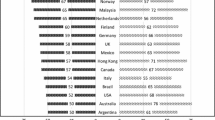Abstract
The old division of labour between fundamental and applied or problem-oriented research has almost disappeared, and with it, the functional distinctions between universities, public labs and industrial and other private research. Doctoral research training can then also become diversified in terms of its content and its location. Closer analysis of ongoing changes, in particular, the emergence of a regime of strategic science, is necessary to specify requirements for a career in science in the coming decades. Disciplines as we know them may not be of major importance, but interdisciplinarity as such is not the answer. For universities, the key challenge is to diversify and recombine, both cognitively and institutionally, into what I call a post-modern university, which includes overlaps and alliances with centres (of excellence and relevance), public labs and various private organizations. In such a university, a doctoral student can wend his or her way through the types of locations, just as is to be expected of his or her later career.
Similar content being viewed by others
Notes
The pattern of knowledge reservoirs and uptake by (scientific) users also occurs in traditional academic research areas, but then normally remains limited to the researchers in that area. One could see this as an extreme (‘pure’) case of the hybrid picture sketched in the main text. Historically, such ‘pure’ areas are in fact a recent phenomenon (from mid-19th century on). Therefore, when Gibbons et al. speak of Mode 1, the academic–disciplinary mode, this is not the basic pattern of scientific research, but a historically contingent regime covering roughly a century, from 1870 to 1970. It is within this regime that PhD training as we used to know it was shaped.
The original French text is slightly different, and more convincing. For example, the final sentence reads: “.. les ingénieurs sortent de l’École non seulement formés aux métiers traditionels, mais prêt à saisir, voire à inventer, les emplois de demain: multimédia, communications, ingéniérie de la conception …”
Interestingly, in the Netherlands research in these two areas was funded by different organizations (the national funding agency NWO and the dedicated organization ZON, Health Care Research Netherlands), but the Medical Council of NWO recently merged with ZON to exploit overlap and synergy.
In the Netherlands these would be the National Institute of Public Health and the Environment (RIVM) and the Netherlands Bureau for Economic Policy Analysis (CPB).
The PhD dissertation is a type of product that will never be required in the later career, so why train students how to do it? It is an initiation rite, but even that will become less important because the “tribes” (cf. Becher, 1989) are less clear (“porous”) and of varying composition.
References
Becher, T. (1989) Academic Tribes and Territories. Intellectual Enquiry and the Cultures of Disciplines, Milton Keynes: The Society for Research into Higher Education and Open University Press.
Brown, J.S. and Duguid, P. (1996) ‘Universities in the Digital Age’, in Change (The Magazine of Higher Learning) July/August 1996, 11–19.
De Boer, H., Huisman, J., Klemperer, A., vd Meulen, B., Neave, G., Theisens, H. and vd Wende, M. (2002) Academia in the 21st Century. An analysis of Trends and Perspectives in Higher Education and Research, The Hague: AWT (Adviesraad voor het Wetenschaps-en Technologiebeleid), September 2002.
Disco, C., Rip, A. and vd Meulen, B. (1992) ‘Technical innovation and the universities: divisions of labor in cosmopolitan technical regimes’, Social Science Information 31(3): 465–507.
Etzkowitz, H. and Leydesdorff, L. (2000) ‘The dynamics of innovation: from National Systems and ‘Mode 2’ to a triple helix of university–industry–government relations’, Research Policy 29: 109–123.
European Science Foundation . (2002) Agents for Change. Bringing Industry and Academia together to Develop Career Opportunities for Young Researchers, Policy Briefing 17 [Report of a meeting sponsored by ESF with Science Magazine Next Wave and the Karolinska Institute, Stockholm (Sweden), 24–25 March 2002].
Gibbons, M., Limoges, C., Nowotny, H., Schwartzman, S., Scott, P. and Trow, M. (1994) The New Production of Knowledge. The Dynamics of Science and Research in Contemporary Societies, London: Sage.
Homburg, E., Rip, A. and Small, J.S. (2000) ‘Chemici, hun kennis en de industrie’, in J.W. Schot, H.W. Lintsen, A. Rip, A.A. Albert de la Bruhèze (eds.), Techniek in Nederland in de twintigste eeuw, deel II, Zutphen: Walburg Pers., pp. 299–316.
Irvine, J. and Martin, B.R. (1984) Foresight in Science. Picking the Winners, London: Frances Pinter.
Nowotny, H., Scott, P. and Gibbons, M. (2001) Re-Thinking Science. Knowledge and the Public in an Age of Uncertainty, Cambridge: Polity Press.
Rip, A. (1992) ‘Expert Advice and Pragmatic Rationality’, in N. Stehr and R.V. Ericson (eds.) The Culture and Power of Knowledge, Berlin and New York: De Gruyter, pp. 357–373.
Rip, A. (1997) ‘A cognitive approach to relevance of science’, Social Science Information 36(4): 615–640.
Rip, A. (2000) ‘Fashions, Lock-Ins, and the Heterogeneity of Knowledge Production’, in M. Jacob and T. Hellström (eds.) The Future of Knowledge Production in the Academy, Buckingham: Open University Press, pp. 28–39.
Rip, A. (2002a) ‘Regional innovation systems and the advent of strategic science’, Journal of Technology Transfer 27: 123–131.
Rip, A. (2002b) A co-evolutionary perspective on ELSI, CTA and other attempts at re-contextualization of science and technology in society. Paper Presented to the Bi-annual Conference of the European Association for the Study of Science and Technology, York (UK), 31 July–3 August 2002.
Rip, A (2002c) ‘Science for the 21st Century’, in P. Tindemans, A. Verrijn-Stuart and R. Visser (eds.) The Future of the Sciences and Humanities. Four Analytical Essays and A Critical Debate on the Future of Scholastic Endeavour, Amsterdam: Amsterdam University Press, pp. 99–148.
Stokes, D.E. (1997) Pasteur's Quadrant : Basic Science and Technological Innovation, Washington, DC: Brookings Institution Press.
Ziman, J. (1994) Prometheus Bound. Science in a Dynamic Steady State, Cambridge: Cambridge University Press.
Author information
Authors and Affiliations
Rights and permissions
About this article
Cite this article
Rip, A. Strategic Research, Post-modern Universities and Research Training. High Educ Policy 17, 153–166 (2004). https://doi.org/10.1057/palgrave.hep.8300048
Published:
Issue Date:
DOI: https://doi.org/10.1057/palgrave.hep.8300048




